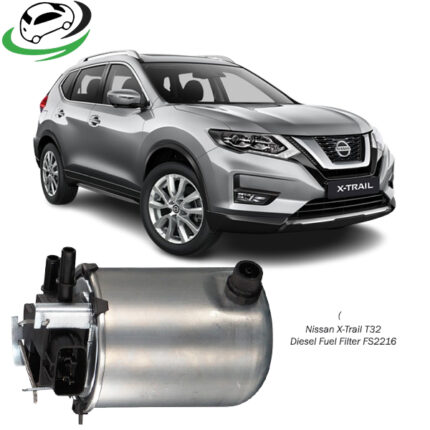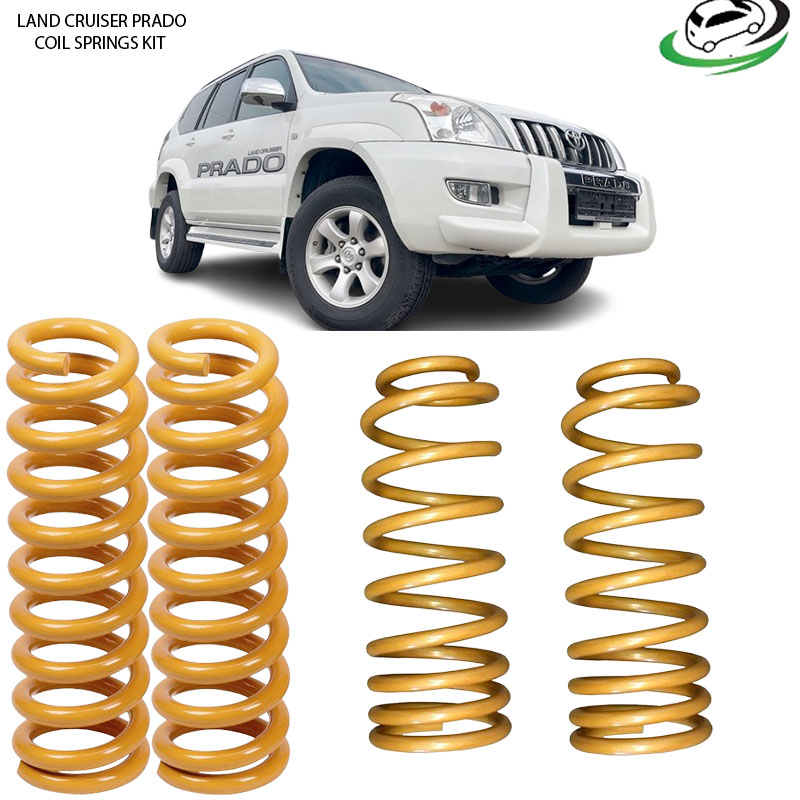-11%
Set Toyota Land Cruiser Prado 120 Series Front & Rear Coil Springs Kit
Coil springs are an essential part of a vehicle’s suspension system. They are designed to absorb and store energy, providing support and stability for the vehicle by cushioning impacts from the road. These springs help maintain the height and balance of the vehicle and contribute to a smooth ride by dampening road shocks. Coil springs are typically made of high-strength steel and are engineered to withstand constant compression and extension as the vehicle travels over uneven terrain.
In this guide, we will explore the function, benefits, types, and maintenance tips of front and rear coil springs kits for vehicles.
Function of Front and Rear Coil Springs
Front Coil Springs
The front coil springs primarily absorb the weight of the front section of the vehicle, which includes the engine and other front-end components like the steering system and front wheels. They are typically paired with struts or shock absorbers that assist in controlling the movement of the spring as it compresses and rebounds.
Key functions of front coil springs include:
- Supporting Vehicle Weight: They bear the weight of the engine and other front-end components, maintaining the vehicle’s height.
- Improving Steering: By stabilizing the front of the vehicle, they help ensure proper steering and handling, which is especially important during braking or cornering.
- Absorbing Road Shocks: They soften the impact from road irregularities such as potholes or bumps, ensuring the ride remains comfortable.
Rear Coil Springs
The rear coil springs provide stability to the back of the vehicle, where the weight of cargo and rear passengers is concentrated. These springs may have a different design from the front, depending on the vehicle’s weight distribution and intended use.
Key functions of rear coil springs include:
- Supporting Rear Weight: They help carry the load of passengers, luggage, and any extra cargo.
- Maintaining Vehicle Height: They ensure the vehicle remains level, preventing sagging in the rear, which could affect the vehicle’s handling and performance.
- Stabilizing the Vehicle: Rear springs provide balance, particularly important for rear-wheel-drive cars or trucks that carry heavy loads.
- Absorbing Road Shocks: Just like the front springs, they smooth out the ride by mitigating the effects of uneven surfaces on the rear wheels.
Types of Coil Springs Kits
Standard Coil Springs
Standard coil springs are the most commonly used type. They offer a balanced performance that suits most vehicles, including sedans, SUVs, and trucks. They provide good handling, comfort, and stability for everyday driving situations.
Performance Coil Springs
Performance coil springs are designed for drivers who want improved handling, cornering, and a firmer ride. They are stiffer than standard coil springs and are often used in sports cars or vehicles that are driven aggressively. Performance springs may also lower the ride height, giving the vehicle a sportier stance and improving aerodynamics.
Progressive Rate Coil Springs
Progressive rate coil springs offer variable stiffness depending on the amount of compression. Under light loads, they provide a soft and comfortable ride, but under heavier loads or during sharp turns, they stiffen up to prevent excessive body roll. These springs are ideal for drivers who need versatility in their vehicle’s suspension system.
Heavy-Duty Coil Springs
Heavy-duty coil springs are designed for trucks, SUVs, and vehicles that frequently carry heavy loads. They are made with thicker coils and offer more support than standard springs. These springs are particularly useful for vehicles used for towing or carrying substantial cargo.
Benefits of Front and Rear Coil Springs Kits
1. Improved Ride Quality
Coil springs absorb road shocks, ensuring that passengers experience a smoother ride. Without coil springs, every bump or pothole on the road would cause a jarring experience. Properly functioning coil springs help minimize discomfort, which is particularly beneficial on long trips.
2. Better Vehicle Control
By stabilizing the vehicle’s weight, coil springs play a critical role in maintaining proper control over the vehicle. This stability is particularly evident when steering or braking. Front and rear coil springs also help reduce body roll during turns, ensuring the vehicle remains level.
3. Increased Load-Bearing Capacity
For vehicles that frequently carry heavy loads or passengers, coil springs are crucial. Rear coil springs, in particular, help distribute weight evenly, preventing the rear end from sagging. This ensures that the vehicle maintains its ride height and doesn’t compromise its handling or suspension geometry.
4. Extended Suspension Lifespan
A good set of coil springs reduces the strain on other suspension components such as shock absorbers, control arms, and bushings. By absorbing a large portion of the forces caused by road irregularities, they prevent premature wear on these parts.
5. Improved Off-Road Capability
For off-road vehicles, heavy-duty or progressive-rate coil springs provide enhanced ground clearance and stability on uneven surfaces. They are essential for vehicles like 4x4s or SUVs that are frequently driven off-road, ensuring that the vehicle can handle challenging terrains.
Maintenance of Coil Springs
1. Regular Inspection
Coil springs should be inspected regularly for signs of wear or damage. Rust, corrosion, or cracks in the spring can weaken its structure, potentially leading to failure. Inspect both front and rear springs during routine maintenance checks or whenever the suspension feels compromised.
2. Replace When Needed
Coil springs generally last a long time, but they can wear out due to age, excessive loads, or poor road conditions. If the vehicle feels unusually bouncy, or if there is a noticeable sag in the front or rear, it may be time to replace the coil springs. Driving with worn-out springs can affect the handling and safety of the vehicle.
3. Check for Rust and Corrosion
Coil springs are made from steel, and like any metal, they are prone to rust, especially in areas with salty road conditions. Applying an anti-corrosion coating or regularly cleaning the springs can help prevent rust from compromising their structural integrity.
4. Inspect Shock Absorbers
Shock absorbers and coil springs work together to provide a smooth ride. If the shock absorbers are worn out, they can place additional stress on the coil springs. Make sure that both components are in good working order and replace them simultaneously if needed.
5. Avoid Overloading the Vehicle
Consistently overloading a vehicle can cause the coil springs to sag prematurely. Be mindful of the vehicle’s weight capacity and avoid carrying excessive loads for long periods.
Signs of Failing Coil Springs
- Sagging Vehicle: If the vehicle sits lower on one side or sags in the front or rear, the coil springs may be worn or damaged.
- Unusual Noises: A knocking or creaking sound when driving over bumps may indicate that the coil springs are loose or damaged.
- Poor Handling: Difficulty controlling the vehicle, especially when cornering or braking, can be a sign of worn-out springs.
- Excessive Bouncing: If the vehicle bounces excessively after hitting a bump, the coil springs may no longer be absorbing shocks effectively.
Conclusion
Front and rear coil springs kits play a crucial role in vehicle suspension systems, ensuring a smooth ride, better handling, and enhanced stability. Whether you drive a sedan, truck, or sports car, choosing the right type of coil springs is vital for performance and safety. By understanding their function, benefits, and maintenance, you can keep your vehicle’s suspension in optimal condition, providing a comfortable and controlled driving experience.
Follow us on Facebook for more parts.




Reviews
Clear filtersThere are no reviews yet.